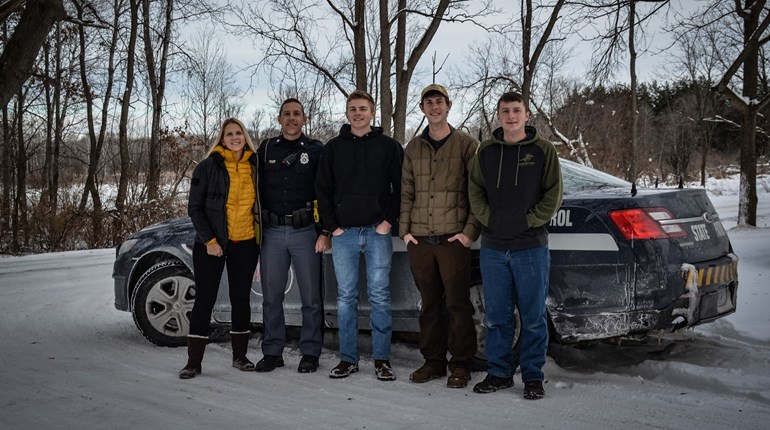
Most people who concealed carry do so for safety. We train and prepare so that we can protect ourselves and those we love. When traveling in winter, there are a few items concealed carriers should consider adding to our preparedness gear.
Make a List!
Think through your average, and not so average, winter day. Asses the specific risks to you during winter travel? Do you walk, drive or take public transit?
We’ll look at concealed carry, personal safety and vehicle safety in relation to colder weather.

Concealed Carry in Winter
Many winter commutes will occur in the dark. You might consider adding a light or laser to your firearm, or at least carrying a good flashlight on your person.
Being able to see your target and your sights in the dark is not always easy. If you can, train on a range in a low-light setting in order to understand how your vision and sights will present in a real situation. In order to get a sight picture, we need to be able to see not just the sights, but their relation to the target. This is difficult to do in the dark, but not impossible. A light that can illuminate the target or a laser sight makes the act of putting your aim where it needs to be much more attainable.

The change of seasons is also a good reminder to check your concealed-carry magazine. Repeated unloading and reloading can sometimes compress projectiles into the case, leading to pressure issues. Look at your rounds when unloading and reloading to make sure the ammunition and magazine are in good working order. Give any spare magazine you might keep in your car a once over as well. Many people clean out their cars with changing seasons, which provides a good opportunity to check extra magazines.
Personal Safety
Winter means we need to add a layer or two of protection to our bodies—against the cold rather than an attacker. How you layer up is worth attention. Choosing clothes that allow access to your concealed carry is important! Test what you wear with your method of carrying concealed.
If you’re too busy being cold, it is difficult to take in your surroundings. Anyone shivering and huddled up outside, oblivious to their surroundings, is an easy target. Wearing a neck gator, hat and gloves will help you embrace the winter weather while staying alert.

Winter clothing to store in your vehicle:
- Hat, gloves, neck gator
- Sweatshirt or hooded layer
- A real jacket anytime you drive more than a few miles
- Boots: if you dress up for work, keep a pair of boots in the car for snow days or car trouble.
- Handwarmers: if you are stuck in your vehicle and have to wait for a tow
- Blanket: another layer if you run into car trouble
- Sunglasses for sunny winter days

A “go bag” for winter can be as simple as a large tote that you leave in the car. A bag to bring your belongings to and from your car also frees up your hands. A simple method of carrying items will keep your hands free in case you need to defend yourself. This is especially important if you park in a lot, on the street or in a shared garage where you have a longer trek to your front door than from a driveway.
Vehicle Preparedness
If you have never had a dead battery or a flat tire, I envy you. Having the right tools is key to fixing some of the most common and most frustrating car troubles.
Jumper Cables and Chargers
Jumper cables and the know-how to use them are invaluable! A portable jump starter is another option for times when there is no other car from which to jump.
Air compressor
Flat tires resulting from screws or nails are common. A portable air compressor is a great tool to have. A tire puncture repair kit can also get you out of a pinch. Being able to get out of harm's way and to a gas station or repair shop can mean the difference between sitting for hours on a busy highway or getting to a safe place. If you hunt or venture off-road, a portable compressor is a real plus! Mine has saved me multiple times.
Gas and Fluids
Having gas or a gas can on hand might mean the difference between a good day and a bad one. I’m not a fan of carrying gas in my car on a daily basis. But if you’re off-road or in a remote location, a small gas can may help! Even a gallon can get most cars 10 to 20 miles.
I do carry brake fluid, power steering fluid, transmission fluid and oil on a daily basis. If you put enough miles on your car (I usually add more than 50,000 a year), you will need them. For example, if you blow a transmission line in the Badlands of South Dakota, a can of power steering fluid isn’t going to fix it, but at least you’ll know what to buy when you get help. Having a bottle of the proper fluids for your vehicle is helpful, because even if you can’t fix the problem, it will make it easier for others to help you.
Basic Tools
A tire pressure gauge and an ice scraper are important and cheap tools to have on hand. If you drive in extremes of snow and ice, a tow strap or chains might be worth adding.
Besides a tire jack and lug wrench, you should make sure that if your car has locking lug nuts, you have the key tool. The key tool (a special socket for the lug nuts) is designed to prevent tire theft, but if you don’t have it, you will be in trouble. Screwdrivers, pliers and a socket set are also invaluable.
No matter how you travel in winter, a little preparedness can go a long way in helping you stay safe and be ready for anything.
About the Author: Becky Yackley competes in the shooting sports across the country and around the world with her husband and three sons. She has spent much of the last 20 years holding down the fort while her husband proudly serves our country in both the Marine Corps and state law enforcement. Her writing, blogging, and photography are ways that she shares her unique perspective on firearms, competition, hunting, and the Second Amendment, especially as it applies to mothers on their own. She grew up the daughter of a gunsmith, and with her siblings competed in NRA Highpower and Smallbore, and she has since competed in more disciplines than almost any woman involved in the shooting sports. From IPSC, USPSA, Bianchi Cup, 3 Gun and more, she enjoys sharing that to be proficient and knowledgeable with a firearm is within the reach of anyone! She’s the founder a 501c.3, 2A Heritage Ltd., and works with industry partners and other volunteers who share the ethos of bringing new youth into the shooting sports with personal commitment to safely sharing an historically American pastime.















































